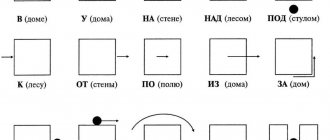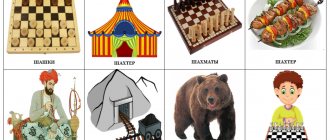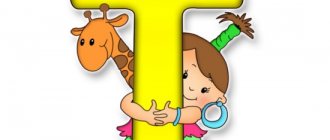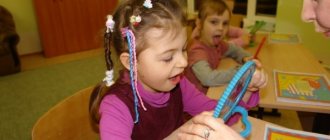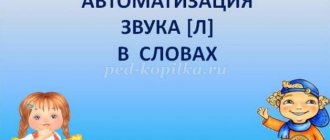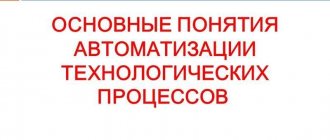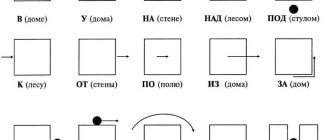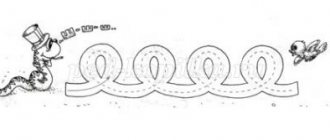Games for automating sounds in the work of a speech therapist at a preschool educational institution
Games for automating sounds in the work of a speech therapist at a preschool educational institution
Author : Petrichenko Elena Nikolaevna, speech therapist teacher at MBDOU DSKV No. 31, Yeysk Goal: to increase children’s interest in the lesson on automating sounds, which will allow them to quickly consolidate the given sounds. Objectives: - increasing motivation for classes on automating sounds in preschool children; -creation of original manuals for automation classes. Recommended for: teachers, speech therapists, speech therapists, parents, preschool teachers Every year the number of children with problems in sound pronunciation is growing. Difficulties arise in the production, automation and differentiation of sounds in preschoolers. Weak motivation, a large number of problematic sounds, concomitant speech disorders - all this complicates the process of correcting children's speech. In children with severe speech impairments, the primary defect is speech underdevelopment. They have psychophysical deviations of varying severity, which cause disorders of the communicative and generalizing (cognitive) functions of speech. Children of other categories may have speech impairments, but secondary ones. It follows from this that a speech therapist is faced with a variety of disorders, so he must know and apply various methods and technologies in correctional activities. Correction of sound pronunciation consists of several stages: 1. Preparation. At this stage, work is underway on phonemic perception and hearing. Preparing the articulation of the speech apparatus using massage or gymnastics. 2. Sound production. We form the articulatory structure of the sound we are putting on. Usually there is a vowel, then sounds of early ontogenesis. Next are hissing/whistles, L, R. The order may change. 3. Automation of sounds Long stage. The sound is being practiced in isolation, in open and closed syllables, in conjunction with a consonant. Further in words, phrases and sentences. This stage is the longest. Often children quickly get tired of repeating syllables. They become bored and uninteresting. But, as psychologists have proven, the work we do with positive emotions brings the best results. Taking this into account, as well as the fact that the main activity of children is play, it was decided to create visual aids for automating sounds . 1. Neuro-game on sound automation Ш The game is based on walking cards. Help the hero reach his goal. The parts of the neuro-mat are used for the game. The child walks on the mat as indicated on the card. Simultaneously pronounces the syllables indicated on the card. This game is recommended for children with dysarthria and motor alalia. You can simplify the game and “walk” on the mats with your fingers.
2. Neuro game for the sound Sh-S There is a card in front of the child. He names the drawing and with a brush performs the action indicated under the picture.
3. A universal guide for automating sounds. An interesting multifunctional tool for automating various sounds. The picture shows a farm with animals. In front of the child are the pieces of a fence. The child pronounces a series of sounds to the speech therapist, attaching a fence to the picture. Parts of the fence are attached with Velcro. The task
is to build the entire fence so that the animals do not run away.
Second version of the manual: New Year's gifts. Picture of a room with a Christmas tree, separately gifts and a bag. The child names syllables or words using sound automation and at the same time attaches a gift to the picture. The task is to place all the gifts in the room. Gifts and a bag are attached with Velcro.
4. Game “Kisa’s in a sleigh” sound automation C. On the game board there are pictures in circles. The child takes the image of Kitty with a sleigh, applies it to the circles and says: “Kisa has a sleigh...”
We recommend watching:
Speech therapy games for preschoolers Games for the prevention of optical dysgraphia and dyslexia in preschoolers Do-it-yourself speech therapy board games for kindergarten Didactic games for speech therapy classes with preschoolers
Similar articles:
Speech therapy games for preschoolers and primary schoolchildren
DIY speech therapy games for preschoolers
DIY speech therapy games
Speech therapy game for older preschoolers
Speech therapy game for children 5 – 8 years old “Who is faster”
Game techniques for automating sounds in preschoolers
Bibliographic description:
Konovalova, G. A. Game techniques for automating sounds in preschoolers / G. A. Konovalova. — Text: direct // Questions of preschool pedagogy. — 2021. — No. 3 (6). — P. 124-126. — URL: https://moluch.ru/th/1/archive/41/1198/ (access date: 11/18/2021).
The article discusses game techniques for correctional work on automating an isolated sound and reinforcing the correct pronunciation of this sound in syllables.
Key words: sound automation, isolated sound, severe speech disorders, speech therapy classes, gaming techniques
Automation of sound is the consolidation of the correct movements of the articulatory apparatus to pronounce a particular sound. In order to automate a sound, you must first learn to pronounce it in isolation, that is, separately from other sounds. The isolated sound delivered is very fragile, since the child who pronounces this or that sound incorrectly has developed the habit of defective pronunciation. By automating the sound in speech, you get rid of a negative stereotype and reinforce a new correct one. As you know, pronunciation is first fixed in isolation, then in syllables, words, phrases.
In case of severe speech disorders (usually in various forms of dysarthria), the stage of automation is delayed; for a long time the child is unable to correctly pronounce the given sound in syllables and words, not to mention phrases. Repeated repetition of the same speech material quickly bores the child, tires him and makes him reluctant to study. If the child is “stuck” on automating isolated sound, then there is no need to talk about the variety of techniques. He loses interest in speech therapy classes and loses the desire to visit the speech therapist's office. It is very important that the child wants to study with you, and this happens when adults turn the lessons into an interesting and exciting game.
Using various gaming techniques and exercises allows you to solve several problems at once:
– awaken in the child the desire to actively participate in the process of correcting sound pronunciation;
– expand and enrich the range of gaming skills;
– increase cognitive activity and performance of children;
– activate the processes of perception, attention, memory;
– smoothly regulate children’s behavioral difficulties, gradually teaching them to obey the rules of the game;
– increase the volume of correctional influence by including game exercises at various regime moments.
The proposed gaming techniques are intended mainly to automate an isolated sound and reinforce the correct pronunciation of this sound in syllables.
Some gaming techniques:
Who takes longer?
A child and an adult compete in the correct and prolonged pronunciation of a sound. The winner is marked with some symbol (star, snowflake, leaf, circle, etc.). This game can be used to automate whistling, hissing, and sonorous sounds.
Who is bigger?
Any counting material can be used (dogs, mushrooms, squares, etc.). For each correct pronunciation of a sound or syllable, the adult and child each take one figurine. The game can be played with two or three children with the same type of pronunciation disorder.
Teach the bear
An adult takes a finger puppet and asks the child to teach it how to correctly pronounce a particular sound or syllable. The child acts as a teacher, Mishka as a student.
Repeat for the fox
Toys are displayed on the table. For each of them, the child pronounces a sound or a syllable (or a series of syllables). The adult plays along with the child: “How the fox liked it! Mishka didn’t hear, say it again!”
The bee is buzzing
The game is used to automate sound [g]. An adult asks a child to help a bee collect delicious nectar from flowers and take it to the hive. The child places his finger at the beginning of the route and, pronouncing [zh] for a long time, leads his finger along the path. To automate the sound [l], the image of a humming steamship or airplane is selected; for [z] - mosquito; for [w] - snakes, etc.
Show me how it crawls, how it rides...
“Show” how a turtle, a snail, a ladybug crawls, or a car drives. The child places his finger at the beginning of the route and, pronouncing a syllable with an automated sound, leads his finger along the path.
Songs
The game is used to automate the sound [sh]. An adult invites the child to repeat syllabic songs together with a snake: sha-sho-shu-shi... etc. To automate the sound [zh], a picture symbol of a beetle is selected; for [h] - train; for [p] - tiger; for [l] - airplane; for [z] - mosquito, etc.
Build a pyramid
The child strings rings onto the rod of the pyramid. At the same time, he pronounces a given sound or syllable.
Wind the string onto the spool
The child winds the lace onto a spool. At the same time, he pronounces a given sound or syllable.
Exercise with massage spring rings
The child alternately puts massage rings on each finger, repeating the sound or syllable correctly.
Exercise with a massage ball
The child rolls the massage ball between his palms, while pronouncing a given sound or syllable. You can also throw the massage ball up.
Plastic bottle doll
Under the cork-hat, draw a funny face, and instead of a mouth, make a hole with a diameter of 1–1.5 cm. Suggest to the child: “Let’s feed the doll with pasta!” The child feeds the doll with pasta and at the same time pronounces a given sound or syllable.
Beads for your beloved mother
You will need pasta with a large opening and a long string. Task for the child: while stringing pasta on a string, pronounce the given sound or syllable.
Fishing
Make a fishing rod - tie a string with a magnet at the end to a stick, or buy a toy fishing rod. Prepare a basin, throw multi-colored clothespins into it, to which cards with vowel letters are attached, and catch them with a magnet.
The child catches cards with vowel letters, places them on the card with the required consonant letter and reads the forward and backward syllables. The game is played with children 5–7 years old who know letters.
These game techniques allow you to diversify the process of automating sounds, help maintain interest in speech therapy classes, promote the correct pronunciation of sounds, develop attention, memory, and positive emotions in preschoolers.
Literature:
- Komarova L. A. Albums on sound automation. - M., GNOM and D, 2009.
- Seliverstov V.I. Speech games with children. - M., Vlados, 1994.
- Speech therapy: Textbook./ Ed. L. S. Volkova. M., Education, 1989.
- Kosinova E. M. The ABC of correct pronunciation. - M., Eksmo, 2005.
Key terms
(automatically generated)
: child, sound automation, specified sound, syllable, sound, isolated sound, adult, pasta doll, massage ball, correct pronunciation.
Using games and play exercises to automate difficult to pronounce sounds
Automation of sound is the consolidation of the correct movements of the articulatory apparatus to pronounce a particular sound. In order to automate a sound, you must first learn to pronounce it in isolation, that is, separately from other sounds. The isolated sound delivered is very fragile, since the child who pronounces this or that sound incorrectly has developed the habit of defective pronunciation. By automating the sound in speech, you get rid of a negative stereotype and reinforce a new correct one. As you know, pronunciation is first fixed in isolation, then in syllables, words, phrases. In case of severe speech disorders (usually in various forms of dysarthria), the stage of automation is delayed; for a long time the child is unable to correctly pronounce the given sound in syllables and words, not to mention phrases. Repeated repetition of the same speech material quickly bores the child, tires him and makes him unwilling to study.
In my work, I use reminder diagrams for each sound I set:
1. Tongue position
Position of the tongue for the sounds S-S', Z-Z', C
Position of the tongue for the sounds SH-Zh, Shch, Ch, L-L', R-R'
2. Scheme for the correct pronunciation of all sounds.
| A | I | I open my mouth |
| ABOUT | Yo | lip wheel |
| U | YU | I pull my lips into a tube |
| Y | AND | mouth to ears, even sew on strings |
| E | E | mouth to ears, at least the strings are sewn + the jaw goes down |
In my practice, I use the following exercise options: “Kick the ball into the goal . Used to automate the sounds S-S', Z-Z', Ш, Ж, Р, Р'
Simple sound reproduction task. Tongue Twisters. Pure tongues are widely used by speech therapists to automate the sounds; they help to pronounce difficult-to-pronounce poems and phrases correctly and clearly.
“Remember - repeat” : Bark-mountain-nora Hurray-it’s time-game Headlight-para-guitar Yura-Ira-Vera game-kennel-kids plywood-panther-office
Repeat the phrases : Thin bark. There is a hole near the fence. Short pencil. Fragrant pie. Wide threshold. The kids are coming. Smooth road. Hometown. Pink Panther. Old trough. Old barn. Sharp axes. Expensive gift. Hoodie. Ruddy loaf.
“One - many” Mountain-mountains Burrow-holes Hole holes Par-pairs Mosquito-mosquitoes Bazaar-bazaars Headlights pattern-patterns fly agaric-fly agarics ax-axes ball-balls blow-blows set-sets motors-motors
Learn the tongue twister : Tarara-tarara - get up, kids! Tarara-tarara - it's time to go to kindergarten! Tururu-tururu – raising the children. Tyryry-tyryry - there are no children at home.
"Correct Dunno" . The speech therapist suggests distorted pronunciation of words and sentences. By throwing the ball, the speech therapist corrects the speech therapist. For example: I try to pronounce sounds in a melting manner. Etc.
"Say the word"
Tasks requiring mental and verbal activity
Name the words where this sound is hidden at the beginning, at the end, in the middle of the word.
Divide the words into syllables, choose a diagram for each word
Find the extra item
D/game “I know 5 objects” Automation of sounds R-L
I know 5 animate objects with the sound R (radio operator, tractor driver, Roma, tiger, lion cub) I know 5 inanimate objects with the sound R (rocket, radio, rose, crown, varnish)
Differentiation TR,DR,KR,PR, R-L
Repeat after me
Write a story using the names of geometric shapes.
Andrey and I decided to build a from geometric figures . We needed the following shapes: triangle , square , rectangle , line , circle . It took a lot of work . brother Andrei , Pyotr , sister Aleksandr and a neighbor from the third for help . Oh, hard work, but we it !!!!!! We hard !
Not all children need to practice sound in texts - if the child uses the new sound freely without tension, you can immediately move on to “free speaking.” Other children need automation in stories. For this purpose, short stories are selected, rich in sound being practiced. So how do you work with stories? It is necessary to pay attention to the fact that the material is selected from the simplest option to the complex option. When working with stories, both the adult and the child use sound without lengthening it, without increased pronunciation. The sound must be “equal” among other sounds.
Exercise “Say the Word.”
Exercise “Make friends with words.” Look, the evil Kikimora mixed up the words in the sentences! Help the words return to their places: “make friends” with them and pronounce the sentences correctly. Sample: Roma, axe, firewood, chop. — Roma chops wood with an axe.
On, yacht, sail, beautiful. Roma, axe, firewood, chop.
Dad, give roses, mom. Market, to, sell, fruit. Mom, give balls, Rodion. Paradise, basket, boletus, collect, c. House, lifting, build, crane, new.
Exercise “Correct the sentence.” The buffoon decided to make you laugh and came up with these sentences. Listen to them. Find and correct errors.
Gardens grow in roses. Roma cleans up the trash. Artyom bought a watermelon. Chickens feed Marusya. The fish caught the fisherman.
Yegor put on a red scarf. I gave the cake to Raya for his birthday. Vegetable gardens grow in tomatoes and cucumbers.
Exercise “Words tell numbers.” Help me unravel an incomprehensible story. Listen to him carefully. If you hear the name of a number, find the picture next to this number and name it.
On her day off, Raya and her parents went on an excursion to There she saw different animals: Her parents told her that all these animals live in hot countries. Striped had the longest neck, very similar to a horse. And the cubs of the huge carnivore played with each other like kittens. Raya really liked it
Stories of different types are presented:
1. Stories with pictures - a transition from words and phrases to retelling texts. They are short, and the sound most often occurs in only one word, which the child must insert in the right place in the sentence after presenting the picture.
2. Stories-tasks. In this case, too, the initial work is carried out with one or two words. The adult reads the problem, the child is interested in counting and giving the answer - first in one word, then in a full sentence. If successful, the child will happily retell this problem to another person. Make sure that the sound is pronounced correctly in the retelling.
Once the guys caught a lot of crayfish under the driftwood in the pond. “You and I,” he says, “will each have 4 crayfish, and we will give Uncle Roma 5 crayfish.” How many crayfish did Vera and Yura catch in total?
3. Stories with questions are the most wonderful part of the work. The fact is that an unprepared child will not be able to immediately retell the text, even without paying attention to the sounds, he simply will not remember the information. Questions are used to help the child in the retelling process. Our actions: we read the entire story, read the first sentence and ask the questions below, after reading to the end, we invite the child to retell the entire story. As usual, don’t forget about pronunciation. (First, read the whole story. Then we read the sentences one by one, after each we ask questions. At the end, the child retells the story.)
Yura and Ira have a new game. This is a radio. Who…? What…? “I’ll be the announcer,” says Yura. Who…? What does he say...? - This is a microphone. The city of Kovrov speaks. I pass the microphone to another announcer. “Today is a holiday in our city,” says Ira, Who...? What does he say...? — There will be different games and attractions. What will happen…?
4. Ordinary stories , rich in practiced sound. You may also need to ask questions here.
The boy is the opposite. For Yura Ryabinin it’s the other way around. The guys are drawing - Yura is playing games. The guys are preparing their homework - Yura is drawing, the guys are building a house - Yura is jumping. “Guys, let’s give Yura poems by Agnia Barto about a boy in reverse,” says Raya. Yura opens the book and sees the following lines, underlined in red pencil:
5. Compiling a story on a given topic. We offer the child a topic for discussion and words with practiced sounds that the child can use in his story.
If you were a chef in a restaurant, what would you prepare for dinner for first, second and third? Tell us about how you would cook and what. You can tell about this better if you remember how your mother prepares dinner.
At the zoo, the caretaker forgot to close the cages. And one animal ran out of it. Tell us how you would catch this animal if it were a tiger, bison, or zebra.
6. Read the text and retell it.
FIRST CONCERT
Makar was at the conservatory for the first time. His mother and sister came to the concert with him. Makar sat down in a beautiful red chair and looked at the stage. There were large musical instruments there: a drum, a harp, a piano. Soon the orchestra members came out to the audience and brought smaller instruments with them. These were violins, trombones, English horns. The last one to enter the stage was a man in a black tailcoat and turned his back to the audience. He looked at the orchestra members and suddenly began waving his arms. Makar turned to his sister and whispered: “Uncle is angry. He didn’t get the instrument.”
Material for automation of sounds Р, Рь
References used: 1. Arkhipova E.F. Making sounds for dyslalia. 2. Samorokova O.P. Kruglikova T.N. We distinguish sonorous sounds 3. Epifanova O.V. Consonants and vowels are similar, but different. V., 2006. 4. Epifanova O.V. Automation of the sound “L”. V., 2006. 5. Kovshikov V.A. Correction of violations of sound discrimination. St. Petersburg, 2006 6. Zhukova N.S. Speech therapist lessons. Correction of speech disorders. M., 2013. 7. Flerova Zh.M. Speech therapy. Rostov-on-Don., 2000. 8. Pozhilenko E.A. A magical world of sounds and words. M., 2001. 9. Svetlova I.E. Home speech therapist. M., 2002. 10. Reznichenko T.S. We speak correctly. M., 2002. 11. Speech therapy notebook for the sounds R, Rb.
Golder Alina Vasilievna teacher-speech therapist MBOU Secondary School No. 6 Noyabrsk, Yamalo-Nenets Autonomous Okrug


